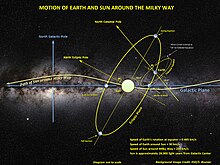Galactic year
Approximate orbit of the Sun (yellow circle) around the Galactic Center
The galactic year, also known as a cosmic year, is the duration of time required for the
Earth years.[2] The Solar System is traveling at an average speed of 230 km/s (828,000 km/h) or 143 mi/s (514,000 mph) within its trajectory around the Galactic Center,[3]
a speed at which an object could circumnavigate the Earth's equator in 2 minutes and 54 seconds; that speed corresponds to approximately 1/1300 of the speed of light.
The galactic year provides a conveniently usable unit for depicting cosmic and geological time periods together. By contrast, a "billion-year" scale does not allow for useful discrimination between geologic events, and a "million-year" scale requires some rather large numbers.[4]
Timeline of the universe and Earth's history in galactic years

The following list assumes that 1 galactic year is 225 million years.
| Time | Event | |
|---|---|---|
| Galactic years (gal) |
Millions of years (Ma) | |
| Past (years ago) | ||
| About 61.32 gal | Big Bang | |
| About 54 gal | Birth of the Milky Way | |
| 20.44 gal | Birth of the Sun | |
| 17–18 gal | 3937 Ma | Oceans appear on Earth |
| 16.889 gal | 3800 Ma | Life begins on Earth |
| 15.555 gal | 3500 Ma | Prokaryotes appear
|
| 12 gal | 2700 Ma | Bacteria appear |
| 10 gal | 2250 Ma | Stable continents appear |
| 6.8 gal | 1530 Ma | Multicellular organisms appear
|
| 2.4 gal | 540 Ma | Cambrian explosion occurs |
| 2 gal | 500 Ma | The first brain structure appears in worms |
| 1.11 gal | 250 Ma | Permian–Triassic extinction event |
| 0.2933 gal | Cretaceous–Paleogene extinction event | |
| 0.0013 gal | Emergence of anatomically modern humans
| |
| Future (years from now) | ||
| 0.15 gal | Mean time between impacts of asteroidal bodies in the order of magnitude of the K/Pg impactor has elapsed.[8]
| |
| 1 gal | All the continents on Earth may fuse into a Pangaea Ultima.[9]
| |
| 2–3 gal | total solar eclipses are no longer possible
| |
| 4 gal | Carbon dioxide levels fall to the point at which C4 photosynthesis is no longer possible. Multicellular life dies out[10]
| |
| 15 gal | Surface conditions on Earth are comparable to those on Venus today | |
| 22 gal | The Milky Way and Andromeda Galaxy begin to collide | |
| 25 gal | Sun ejects a planetary nebula, leaving behind a white dwarf | |
| 30 gal | The Milky Way and Andromeda complete their merger into a giant Milkdromeda[11]
| |
| 500 gal | The Universe's expansion causes all galaxies beyond the Milky Way's cosmic light horizon, removing them from the observable universe[12]
| |
| 2000 gal | Local Group of 47 galaxies[13] coalesces into a single large galaxy[14] | |
Visualisation of the orbit of the Sun (yellow dot and white curve) around the Galactic Centre (GC) in the last galactic year. The red dots correspond to the positions of the stars studied by the European Southern Observatory in a monitoring programme.[15]
See also
References
- ^ Cosmic Year Archived 2014-04-12 at the Wayback Machine, Fact Guru, University of Ottawa
- ^ Leong, Stacy (2002). "Period of the Sun's Orbit around the Galaxy (Cosmic Year)". The Physics Factbook.
- ^ http://starchild.gsfc.nasa.gov/docs/StarChild/questions/question18.html NASA – StarChild Question of the Month for February 2000
- ^ Geologic Time Scale – as 18 galactic rotations
- PMID 24963687.
- S2CID 4331375.[permanent dead link]
- OCLC 808340848.
- ^ Lunar and Planetary Institute (2010), https://www.lpi.usra.edu/features/chicxulub/
- ^ Williams, Caroline; Nield, Ted (2007-10-17). "Pangaea, the comeback". New Scientist. Retrieved 2014-01-02.
- S2CID 3619702.
- S2CID 14964036.
- S2CID 118750775.
- ^ Frommert, Hartmut; Kronberg, Christine (2007-06-05). "The Local Group of Galaxies". University of Arizona. Students for the Exploration and Development of Space. Archived from the original on 2009-09-07. Retrieved 2009-10-02.
- S2CID 12173790.
- ^ "Milky Way Past Was More Turbulent Than Previously Known". ESO News. European Southern Observatory. 2004-04-06.
After more than 1,000 nights of observations spread over 15 years, they have determined the spatial motions of more than 14,000 solar-like stars residing in the neighbourhood of the Sun.


![Visualisation of the orbit of the Sun (yellow dot and white curve) around the Galactic Centre (GC) in the last galactic year. The red dots correspond to the positions of the stars studied by the European Southern Observatory in a monitoring programme.[15]](http://upload.wikimedia.org/wikipedia/commons/f/f8/Sun_in_orbit_around_Galactic_Centre.gif)